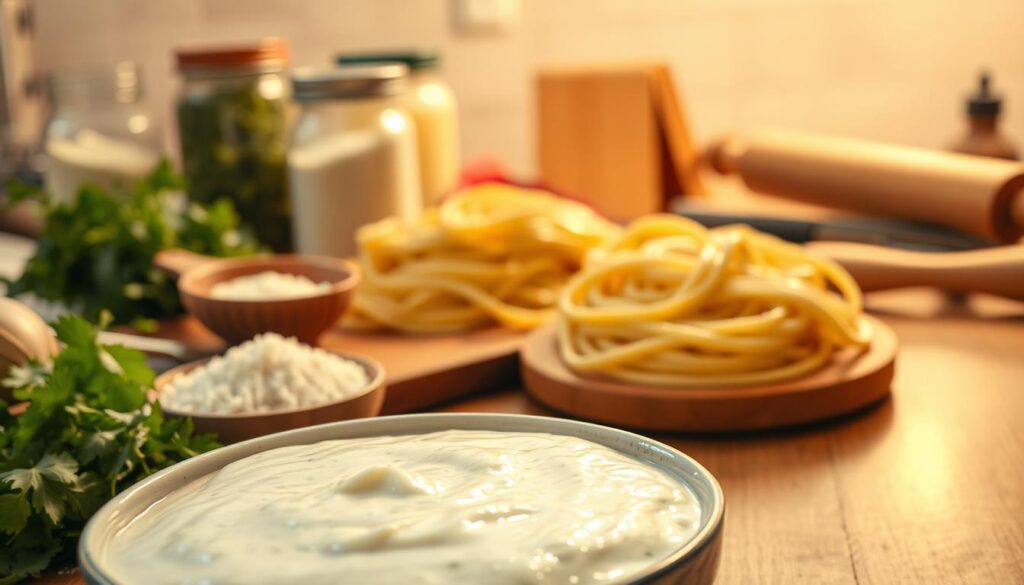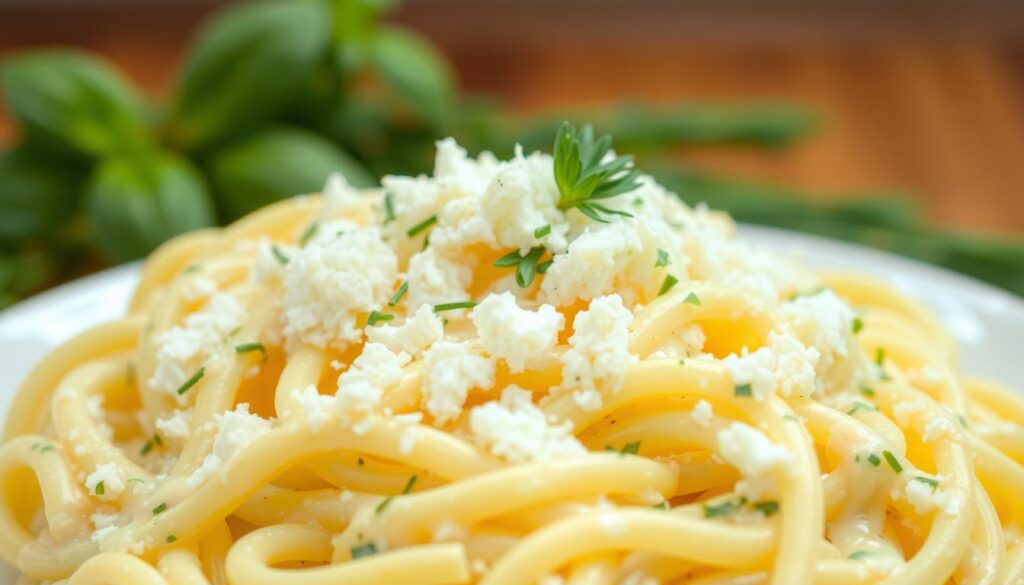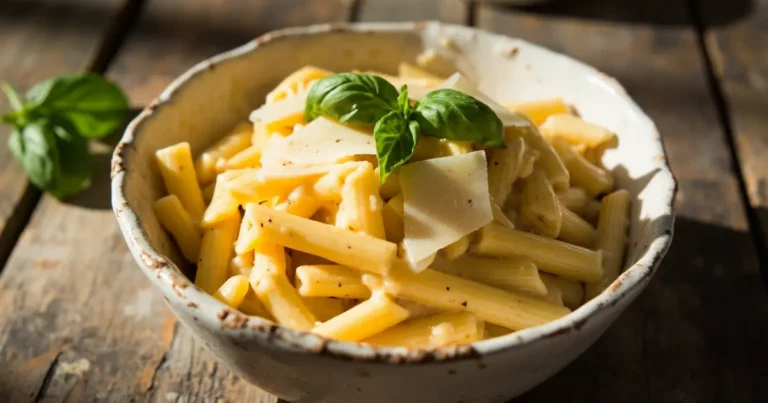best recipes for you
How to Make Cottage Cheese Alfredo Sauce at Home
Table of Contents
Imagine stepping into a cozy kitchen. The smell of fresh herbs and tangy dairy fills the air. You can make creamy, comforting alfredo sauce at home without the heavy cream or guilt. Cottage cheese alfredo sauce is a dish that combines nostalgia with practicality.
It turns a simple weeknight meal into something special. You don’t have to give up on your health goals or budget.

This guide teaches you to make a velvety sauce with cottage cheese as the main ingredient. You’ll learn to create a dish that’s both light and rich. It’s packed with protein and ready in under 30 minutes.
Whether you’re meal prepping, hosting dinner, or just craving comfort, this sauce fits any occasion.
Key Takeaways
- Discover a healthier, budget-friendly swap for classic alfredo sauce.
- Learn to make a protein-rich sauce in under 30 minutes using everyday ingredients.
- Unlock versatility—use the sauce for pasta, casseroles, or even as a veggie dip.
- Avoid added sugars and excess fat with this simplified recipe.
- Master techniques to achieve a smooth, creamy texture every time.
Introduction to Cottage Cheese Alfredo Sauce
Cottage cheese pasta dishes are becoming more popular. They offer a lighter take on classic comfort food. Unlike traditional Alfredo sauce, this version uses cottage cheese instead of cream and butter.
This change results in a velvety texture that’s both rich and lighter. It’s perfect for those who love pasta but want a healthier option.

| Aspect | Traditional Alfredo | Cottage Cheese Alfredo |
|---|---|---|
| Texture | Creamy but heavy | Silky and lighter |
| Nutrition | High in saturated fats | Lower calories, more protein |
| Prep Time | Long simmering | Ready in 10 minutes |
| Cost | Expensive cream bases | Affordable cottage cheese |
Alfredo sauce started in Rome with butter and parmesan. Now, cooks are making it healthier. Cottage cheese pasta replaces heavy cream with cottage cheese, making it lower in fat.
This version works great with spaghetti, fettuccine, or penne. The secret is blending cottage cheese until it’s smooth. This makes the sauce creamy like traditional Alfredo but with 40% fewer calories.
It’s perfect for quick meals, ready in under 15 minutes. No need for long simmering.
“The key is using fresh cottage cheese with no additives,” says culinary expert Lisa Martinez. “It’s the base that makes this sauce so versatile.”
This sauce is great for meal prep or dinner parties. It’s indulgent yet nutritious. Choosing cottage cheese pasta makes your dish both comforting and wholesome.
Benefits of Using Cottage Cheese in Pasta Sauce
Choosing cottage cheese in pasta sauce is more than just a creamy taste. It’s a smart choice for those who care about health and have little time to cook.
Nutritional Advantages Over Traditional Alfredo
Let’s see how cottage cheese stacks up:
| Category | Traditional Alfredo | Cottage Cheese Version |
|---|---|---|
| Calories (per 100g) | 300 | 200 |
| Fat Content (g) | 25g | 12g |
| Protein (g) | 5g | 15g |
The cottage cheese version has 50% less fat and three times more protein. It’s perfect for those watching their calories.
Cost-Effectiveness of Homemade Sauce
Save money without losing quality. Here’s a cost comparison:
| Sauce Type | Cost Per Serving |
|---|---|
| Store-Bought Alfredo | $4–$6 |
| Homemade Traditional Alfredo | $3–$4 |
| Cottage Cheese Alfredo | $2–$3.50 |
Using cottage cheese can cut costs by up to 40% compared to store-bought sauces.
Quick Preparation Time for Busy Cooks
Make this sauce in under 15 minutes:
- Grate cheese and mix ingredients in 5 minutes
- Simmer for 7 minutes on medium heat
- Add seasoning and finish in 3 minutes
This sauce is quick to make. It fits into your busy schedule without losing flavor.
Essential Ingredients for Cottage Cheese Alfredo Sauce
Creating the perfect cottage cheese cream sauce begins with the right ingredients. Each one affects the sauce’s texture, taste, and creaminess. Here’s what you’ll need:
- Cottage cheese (15% fat): Choose high-fat cottage cheese for a smooth texture. Lower-fat types might make the sauce too watery.
- Grated Parmesan: This adds a salty flavor. Freshly grated cheese is best, as pre-grated can be too dusty.
- Garlic (2-3 cloves): Minced garlic adds depth without overpowering the sauce.
- Unsalted butter: It adds richness. You can use olive oil for a lighter version.
- Whole milk or heavy cream: These help balance the sauce’s thickness. Skim milk can be used for a thinner sauce.
- Salt, black pepper, and nutmeg: These seasonings bring all the flavors together.
Quality is key: Use fresh, high-fat cottage cheese for the creamiest sauce. For a dairy-free version, try almond milk or cashew cream. A cottage cheese cream sauce made with store-bought cheese might lack flavor—use a block of Parmesan instead.
| Ingredient | Purpose | Substitute |
|---|---|---|
| Cottage cheese | Base creaminess | Plain Greek yogurt (mix 50/50) |
| Heavy cream | Richness | Coconut milk (full-fat) |
| Unsalted butter | Fatty depth | Olive oil + a pat of margarine |
Make dietary swaps as needed, but keep the ingredient ratios the same. Avoid overmixing, as it can break the cottage cheese curds. Blend until smooth, then stir in other ingredients gently.
Kitchen Equipment You’ll Need
To make cottage cheese alfredo sauce, you need some essential tools. These help with blending and cooking. Here’s what you’ll need at each step:
| Item | Purpose | Alternatives |
|---|---|---|
| Blender or Food Processor | Blends cottage cheese into a creamy base for the sauce | Immersion blender (if you prefer no-mess mixing) |
| Medium Saucepan (3-4 quart) | Heats and thickens the sauce evenly | Large pot with a lid |
| Measuring Spoons & Cups | Ensures accurate ingredient ratios | Digital kitchen scale (for precise measurements) |
| Wire Whisk | Mixes ingredients without overworking the sauce | Fork (if no whisk is available) |
| Colander or Strainer | Drains excess liquid from cottage cheese | Cheesecloth or clean kitchen towel |
Set up your kitchen by arranging these tools within easy reach. A tip: Start by preparing your blender—it’s used first. For cottage cheese alfredo sauce, the right tools are key. Use a blender and saucepan for the best results. Adjust based on what you have, but these are crucial.
Step-by-Step Cottage Cheese Alfredo Sauce Recipe
Learning to make cottage cheese cream sauce is all about detail. Follow these steps to get a smooth base for your cottage cheese pasta.
Preparing Your Ingredients
Start by getting your ingredients ready. Drain the cottage cheese well using a fine sieve. This step removes extra liquid. Cut the garlic and grate the Parmesan into a small bowl. Have a mixing bowl ready with a whisk and a saucepan on the stove.
Blending Techniques for Smooth Sauce
Blend the cottage cheese in a food processor until it’s smooth, about 30 seconds. Add ¼ cup of milk and pulse until it’s creamy. If you still see lumps, strain it through cheesecloth for a silky texture.
Cooking and Thickening Methods
- Sauté minced garlic in butter until it smells great.
- Whisk in the blended cottage cheese mixture and cook on medium-low heat.
- Add warmed milk slowly while stirring constantly to avoid clumps.
- Stir in 1 tbsp cornstarch mixed with water to thicken, if needed.
Final Seasoning Adjustments
Season with salt, pepper, and a pinch of nutmeg. Taste and add lemon juice for a bit of brightness. If it’s too thin, simmer longer or add more cheese. Serve it over fettuccine or penne right away.
Troubleshooting Common Issues with Cottage Cheese Cream Sauce
Even with precise measurements, pasta sauce with cottage cheese can sometimes go awry. Here’s how to fix texture, thickness, or flavor issues quickly:
Fixing a Grainy Texture
If your sauce feels gritty, check your cottage cheese type. Low-moisture varieties often cause clumps. Try: Blend in 1-2 tablespoons of warm milk while mixing. For stubborn lumps, strain the cheese through a sieve before combining. Always blend until smooth—30 seconds to 1 minute works best.
Adjusting Thickness and Consistency
- Too thin? Stir in ¼ cup shredded mozzarella or 1 tbsp cornstarch mixed with water.
- Too thick? Add 2 tbsp hot broth or cream while whisking vigorously.
“Temperature matters—keep the pot warm but not boiling to prevent curdling.” —Chef Maria Lopez, Dairy Specialist
Balancing Flavors When Something’s Off
Too salty? Stir in a beaten egg white to absorb excess salt. Bland? Add ½ tsp garlic powder or a squeeze of lemon juice. For bitterness, mix in a pinch of sugar. Always taste before serving!
Perfect Pasta Pairings for Your Cottage Cheese Sauce
Choosing the right pasta shape is key to enjoying your cottage cheese alfredo sauce. The sauce sticks well to pasta with ridges or nooks. Here’s how to pick the best:
- Fettuccine: Wide flat strands hold the sauce like a spoon. It’s a classic choice for alfredo.
- Penne: Tubular ends catch the sauce, while the smooth surface balances the creaminess.
- Shells: Their hollow centers are perfect for scooping up rich sauces without getting soggy.
- Rotini: Swirled shapes add texture contrasts that make cottage cheese pasta even better.
Whole wheat or gluten-free pastas are great too. Choose shorter cook times to keep them firm. Overcooked noodles can water down the sauce’s flavor. Cook pasta al dente, then toss it with the sauce right away to keep it creamy.
“The best cottage cheese pasta dishes balance sauce-to-pasta ratio. Aim for 1 pound pasta to 1.5 cups sauce.”
Try farro or quinoa pastas for a nutty flavor that goes well with the sauce’s mild taste. Always rinse gluten-free pasta to avoid clumping. Your pasta choice affects the dish’s texture and taste.
Adding Variations to Your Cottage Cheese Pasta
Make your cottage cheese pasta even better by trying new things. Each change lets you enjoy different flavors. So, you can keep making new dishes.
Herb and Spice Enhancements
- Add basil or oregano for fresh herb notes.
- Stir in a pinch of red pepper flakes for heat.
- Try garlic powder or minced garlic for depth.
Protein Add-ins
Cook bite-sized proteins directly in the sauce:
- Grilled chicken strips for protein-rich bowls.
- Sauteed shrimp for a seafood twist.
- Roasted chickpeas or cubed tofu for vegetarian options.
Vegetable Inclusions
Boost nutrition and texture with these veggies:
- Sautéed spinach or broccoli florets.
- Roasted bell peppers or zucchini slices.
- Blanched asparagus tips for a crisp bite.
Tomato Sauce and Cottage Cheese Fusion
Create a creamy rosa-inspired dish by blending tomato sauce with your base. Start with 1/2 cup tomato sauce per 1 cup cottage cheese mixture. Simmer together for 5 minutes to meld flavors. Add a dash of balsamic vinegar for brightness.
Beyond Pasta: Other Delicious Uses for Your Sauce
Make the most of your homemade cottage cheese alfredo sauce. It’s not just for pasta. It can make any meal or snack richer. Here are some ideas:
As a Vegetable Topping
Try it on roasted broccoli, sautéed mushrooms, or steamed asparagus. It’s a game-changer. Here’s a great combo:
- Roast Brussels sprouts at 400°F until caramelized, then toss with warm sauce and grated Parmesan.
- Serve chilled sauce as a dip for raw veggies like carrots or bell peppers.
For Casseroles and Baked Dishes
Use the sauce in layered dishes:
- Potato Gratin: Spread sauce between sliced potatoes and bake until golden.
- Vegetable Bake: Mix with thawed frozen spinach, feta, and the sauce for a 20-minute casserole.
- Lasagna: Substitute traditional béchamel with this sauce in homemade lasagna layers.
Creative Appetizer Applications
Turn the sauce into appetizers:
- Fill baked mushrooms with a mix of sauce, garlic, and breadcrumbs before baking.
- Serve as a dip with toasted baguette slices or pita chips.
- Spread on crostini topped with prosciutto and arugula.
Got leftover sauce? Freeze it in ice cube trays for future meals. Be adventurous with your cottage cheese alfredo sauce. It can make any dish special, from weeknight meals to weekend parties.
Storing and Reheating Your Homemade Sauce
Keeping your cottage cheese cream sauce fresh is key. Refrigerate leftovers in an airtight container within 2 hours. Store it in the main fridge at 40°F or below. Enjoy it within 3-4 days for the best taste.
- Freezing: Pour cooled sauce into freezer-safe containers, leaving 1 inch headspace. Freeze up to 2 months. Thaw overnight in fridge before use.
- Reheating: On stove: Warm over medium-low heat, stirring constantly. In microwave: Heat in 30-second bursts, stirring each time. For baked dishes: Spread frozen sauce on lasagna layers and bake at 375°F for 25-30 minutes.
If sauce thickens, thin it with pasta water or milk. For separation, whisk in butter or heavy cream. Always throw away sauce with bad smells or mold.
“Always let sauce cool completely before freezing to prevent texture changes.”
Conclusion
Making cottage cheese Alfredo sauce at home is a game-changer. It lets you enjoy creamy pasta without the heavy fats of traditional sauces. This method is not only budget-friendly but also quick to prepare.
The mix of cottage cheese’s mild taste and simple ingredients makes for a satisfying dish. You can serve it with spaghetti, lasagna, or even as a topping for zucchini boats. It’s all about your preference.
Try adding spinach, grilled chicken, or a bit of marinara to create a unique flavor. Adjust the garlic or Parmesan to your liking. Leftovers are easy to store, making meal prep a breeze for later.
By mastering this recipe, you open up a world of possibilities in the kitchen. Healthy cooking doesn’t have to mean sacrificing flavor. Start with the basic recipe and then experiment with different variations.
Homemade sauces give you control over what goes into your food and how much you spend. Every new recipe you try boosts your confidence in the kitchen. With this sauce, you’re not just cooking dinner—you’re creating something special with simple, wholesome ingredients. Next time you want creamy pasta, try cottage cheese and let your imagination run wild.
FAQ
What is cottage cheese alfredo sauce?
Cottage cheese alfredo sauce is a healthier take on traditional alfredo. It’s made with cottage cheese for a creamy texture and rich flavor. This sauce is low in fat and calories, making it great for pasta or other dishes.
How can I make a pasta sauce with cottage cheese?
Start by blending cottage cheese until it’s smooth. Then, mix it with Parmesan cheese, garlic, and your favorite seasonings. Heat it gently on the stove to blend the flavors. You can adjust the sauce’s consistency with milk or cream if needed.
What are some variations to the cottage cheese cream sauce?
You can add herbs, spices, and protein like grilled chicken or shrimp to your sauce. For a twist, mix in tomato puree to create a tomato sauce and cottage cheese fusion.
How do I store cottage cheese alfredo sauce?
Keep your sauce in an airtight container in the fridge for 3-4 days. If you want to store it longer, freeze it. Just remember, the texture might change a bit when it thaws.
Can I use cottage cheese in baked dishes?
Yes, cottage cheese alfredo sauce is perfect for casseroles and baked dishes. It adds creaminess to lasagna or vegetable bakes. It also boosts flavor and nutrition.
What pasta pairs best with cottage cheese pasta sauce?
Fettuccine, penne, and rotini are great with cottage cheese sauce because they hold it well. For a healthier option, try whole wheat or gluten-free pasta.
How can I fix a grainy texture in my sauce?
If your sauce is grainy, blend it longer until it’s smooth. Heat it gently to avoid curdling. Using finer cottage cheese can also help achieve a silkier texture.
What other dishes can I make with cottage cheese alfredo sauce?
Use cottage cheese alfredo sauce as a topping for steamed veggies or in savory baked goods. It’s also great as a dip for crostini or stuffed mushrooms. Its versatility makes it a fantastic addition to many meals.






